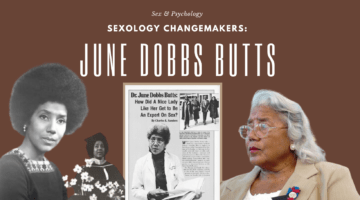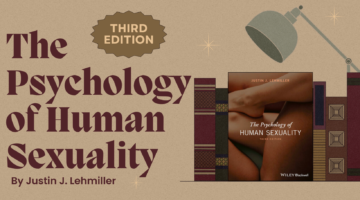Sex as Self-Injury: People Who Intentionally Seek Harm Through Sex
October 9, 2020 by Justin Lehmiller
Non-suicidal self-injury (NSSI) refers to deliberate, self-inflicted damage to the body that is intended to cause pain, but not to end one’s life. NSSI is not uncommon—in fact, some reports suggest that as many as 1 in 7 college students have engaged in this before, with some of the most common behaviors including intentional cutting or burning of the skin.
NSSI is often related to factors such as emotional dysregulation and low self-esteem, and it may be a way that some people try to relieve negative feelings or induce positive feelings.
Most people who have studied NSSI have not looked at sexual behaviors, but a recent study published in the Journal of Sex Research suggests that some people may use sex as a means of self-injury—for them, sex is a purposefully sought way of harming the self.
Researchers surveyed 199 adults (most of who identified as women and who were age 28 on average) about their experiences with sex as self-injury, which was defined as having “repeatedly sought sexual situations that have caused you physical and/or mental harm and that have affected you in your life.”
Participants were asked open-ended questions about ways in which they’ve used sex for self-injury and how and why they did this. Researchers analyzed the contents of participants’ answers to look for common themes. What they found was that people sometimes sought psychological harm, physical harm, or both.
Seeking psychological harm through sex
What we’re talking about here are situations in which one agrees to have sex despite (1) not wanting or desiring it and/or (2) not possessing any interest in the other person, such as having sex with someone that you personally consider to be disgusting. In these cases, the goal is generally to punish or humiliate oneself.
For example, in the words of one participant: “[I] have had intercourse with guys I actually did not want to be with and had sex when I did not want to with the aim of hurting myself.”
Note that this behavior should not be conflated with sexual masochism, in which someone might seek humiliation or pain because they find it pleasurable and sexually gratifying. In this study, pleasure wasn’t really discussed in the way participants described these behaviors—they weren’t doing it for a sexual thrill, which makes this behavior distinct. Also, masochists and others in the BDSM community generally have a lot of advance communication in which they set clear boundaries and limits, as well as establish “safewords” in order to avoid serious harm. Those things aren’t really present among persons using sex as self-injury—they aren’t taking the same safety precautions that most BDSM practitioners do.
Seeking physical harm through sex
These are sexual situations in which one intentionally seeks out physical violence, such as having sex with an abusive person they knew was likely to hit, beat, or otherwise hurt them. Again, the motivation here is not pleasure—rather, they are looking for injury and pain.
In the words of one participant: “I have sought older men who want to dominate me, and I have let them do basically whatever they want with me. At the most it has been eight men at the same time. In most of the cases I have not been allowed to leave when I wanted to after I entered the door. The injuries have been many, both physical and mental. Despite this have I returned again.”
Some participants described these situations as “self-elected rape,” but they made a distinction between this behavior and sexual assault because they voluntarily and repeatedly sought out these situations, as opposed to being forced into them.
******
Most participants reported that these behaviors began in adolescence and they generally described the other persons in these encounters as casual contacts; however, some described seeking sex as self-injury within the context of an ongoing relationship. In addition, some talked about using masturbation as a means of self-injury, such as by causing damage to genital tissue.
One of the main motivations people described for engaging in these behaviors was emotional regulation, including seeking relief from depression, anxiety, and contempt for the self.
In the words of one participant: “I felt very bad and worthless. Sought men (and women but mostly men) on the Internet and left my address. I did not know who they were, how old and so on but I did not care either, I just wanted to get rid of my anxiety, sorrow and shame. “
Many mentioned a history of sexual or other abuse, low self-esteem, and hatred of their own body as contributing factors—and they saw self-injury as an effective way of dealing with their psychological issues. For example, some talked about using physical pain as a way of “easing” emotional pain by providing mental escape.
However, some also talked about using sex as self-injury as a way of seeking either positive or negative confirmation of their self-views. This might sound paradoxical, but for some, having sex under these circumstances still made them feel wanted, so they found it validating to a degree. For others, though, this type of sex was a way to confirm their own feelings of worthlessness.
Many also described this behavior as hard to stop—as a compulsion of sorts. They had negative feelings about the self, felt some temporary relief through self-injurious sex, but them felt even worse afterwards because there was an increase in shame and guilt for what they had done. This created a cycle of behavior that then escalated into even more severe harm over time.
Some reported using alcohol and drugs to facilitate this behavior, and many said that shame prevented them from seeking help—they didn’t feel like there was anyone they could talk to about this.
What the results of this study tells us is that sex as self-injury may be a variant of NSSI in which people seek to cause intentional harm to the self or body through sex, often motivated by an attempt to regulate their emotional state.
This behavior is distinct from masochism and should not be lumped into the same category as BDSM, given that sexual pleasure is not the overriding goal or motive here and typical kinky sex precautions (i.e., ensuring that everything is “safe, sane, and consensual”) aren’t being taken.
The authors of this study argue that sex as sex-injury should be viewed as a form of sexual violence because even though participants said they had some control over the situation and that these acts were intentional, “involuntary sexual and physical violence were repeatedly described as occurring” and the injuries experienced were often severe. These are persons with poor mental health who appear to be especially vulnerable to exploitation and abuse.
Given that this is among the first studies to explore sex as self-injury, much remains unknown. However, it is an important area for future studies to explore in order to better understand how common it is, develop appropriate treatments, and provide effective support to these individuals.
Want to learn more about Sex and Psychology? Click here for previous articles or follow the blog on Facebook (facebook.com/psychologyofsex), Twitter (@JustinLehmiller</ a>), or Reddit (reddit.com/r/psychologyofsex) to receive updates. You can also follow Dr. Lehmiller on YouTube and Instagram.
To learn more about this research, see: Fredlund, C., Wadsby, M., & Jonsson, L. S. (2020). Motives and manifestations of sex as self-injury. The Journal of Sex Research, 57(7), 897-905
Image Source: 123RF/Tinnakorn Jorruang
You Might Also Like:

Dr. Justin Lehmiller
Founder & Owner of Sex and PsychologyDr. Justin Lehmiller is a social psychologist and Research Fellow at The Kinsey Institute. He runs the Sex and Psychology blog and podcast and is author of the popular book Tell Me What You Want. Dr. Lehmiller is an award-winning educator, and a prolific researcher who has published more than 50 academic works.
Read full bio >


